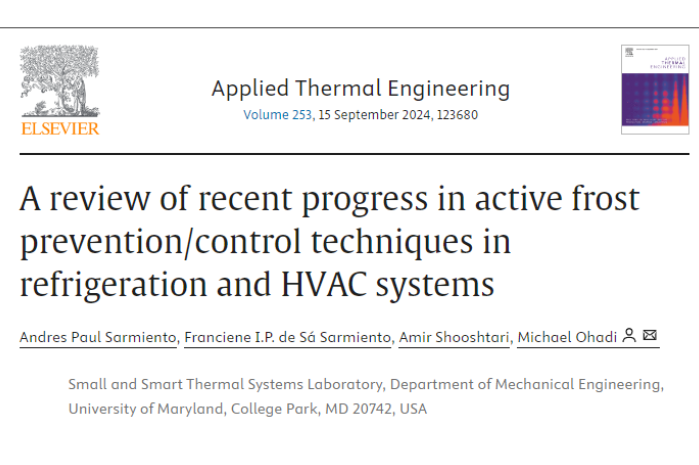It’s a cold, hard fact: Frost accretion commonly plagues HVAC&R systems, impacting the equipment’s operating efficiency and leading to increased energy consumption. A research team from the University of Maryland Center for Environmental Energy Engineering (CEEE) explores energy-effective frost control techniques in the September 15, 2024 issue of Applied Thermal Engineering. The literature review examines frost prevention and frost removal strategies.
The paper, which was selected for the journal’s Editor’s Choice Award, was written by postdoctoral researchers Andres Paul Sarmiento and Franciene I.P. de Sá Sarmiento, Research Professor Amir Shooshtari, and CEEE Co-Founder and Mechanical Engineering Professor Michael Ohadi. The authors compare various frost prevention/control techniques and consider key parameters, including effectiveness, power consumption requirements, additional accessories requirements and advantages/disadvantages.
The researchers also identify research gaps and opportunities for future R&D. To improve system efficiency, reliability and stability, they recommend research in the following areas:
- The development of frost accretion tracking methods, such as resistive sensors and artificial vision, integrated into the control loop of HVAC and heat pump (HP) systems to enable the start or stop of the defrosting cycle on demand, reducing energy consumption and enhancing the system’s coefficient of performance (COP)
- Integrating highly efficient components such as heat exchangers, compressors, and expansion valves into HVAC and HP systems to reduce system energy consumption, enhancing the overall COP of both HP and HVAC systems
- Exploring the electric field-assisted method and ultrasonic vibrations, which are promising candidates for reducing defrost energy consumption in cold regions
- Studies on the effects of low-GWP refrigerants on defrosting time and energy consumption, and optimization of related components
- Combining active and passive defrosting techniques that would allow heat pump systems to operate efficiently in high-humidity and very cold climates, minimizing energy consumption and maximizing efficiency
- Establishing a baseline for comparison on active frost removal and control techniques, making it easier to compare different strategies.
Download the paper: “A review of recent progress in active frost prevention/control techniques in refrigeration and HVAC systems.”

